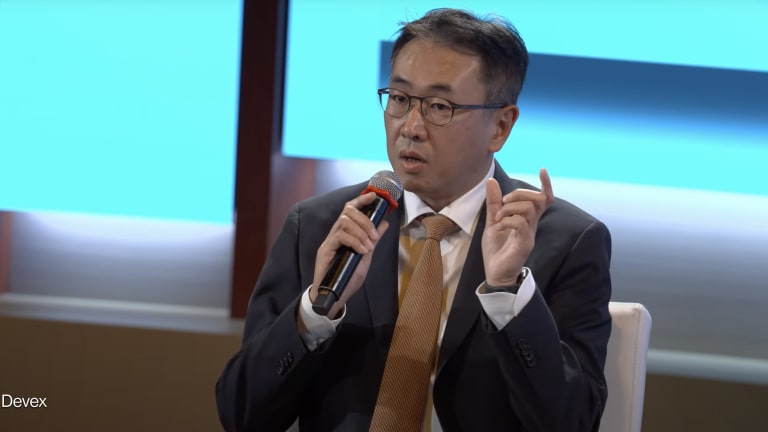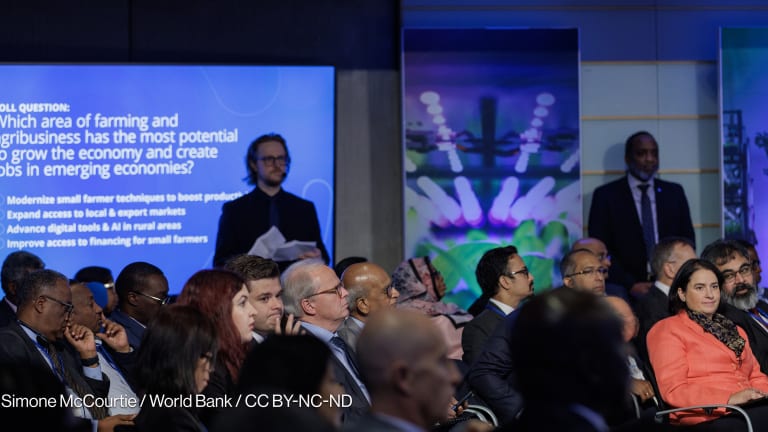What does the World Bank's Silicon Valley strategy look like now?
Its disruptive technology approach was catalyzed in the former president's office, but the World Bank Group's Silicon Valley strategy was never going to vanish with Jim Kim's departure, staff explain to Devex.
SAN FRANCISCO — When former World Bank President Jim Kim announced he was leaving, it came as a surprise not only to the institution but also to the technology companies he had built relationships with in California’s Bay Area. But last week, it seemed like business as usual, as leaders from the World Bank Group’s Africa regional leadership team gathered for meetings in Silicon Valley with groups like ride-sharing company Uber, Earth imaging company Planet Labs, and professional networking site LinkedIn. The institution’s Silicon Valley strategy was never going to vanish with Kim’s departure, staff explained to Devex. “It was never just a Jim Kim thing. It is actually more our clients’ thing than our thing.” --— Hafez Ghanem, vice president, World Bank for Africa The partnerships and the broader disruptive technology strategy was catalyzed in the president's office, and Kim previously represented the World Bank in meetings in San Francisco, California, exploring potential future partnerships. But the bank already has active partnerships underway with Silicon Valley companies such as Airbnb, having teamed up with the online marketplace for hospitality to support tourism in emerging markets. Now the onus is on others to move these conversations forward. At this week’s World Bank Spring Meetings in Washington, D.C., the bank’s Development Committee will review a number of proposed tech-related programmatic approaches — and its approval could serve as a springboard to mainstream a disruptive technology strategy throughout the institution. Extending beyond the president’s office In the frequent trips Kim made to Silicon Valley, Edward Hsu, whose official title was then senior adviser in the office of the president at the World Bank Group, was often seen by Jim Kim’s side. They worked closely together on some of the active World Bank-Silicon Valley companies partnerships. Previously, Hsu led a number of special initiatives for Kim, but over time, this disruptive technology portfolio emerged as a priority and became his full-time job, which continues on today: “The more I started to work on it, the more work there was, and the more demand as well,” he said. That demand came not only from within the World Bank, but also from clients, said Boutheina Guermazi, who leads the World Bank Transport and ICT Global Practice, which supports developing countries in areas such as broadband infrastructure, mobile networks, and digital government. She emphasized the importance of conversations not only in Silicon Valley but also in other technology hubs around the world, such as Singapore, where the World Bank Group sent its South Asia regional leadership team for a similar trip last year. Hsu has since joined the World Bank Infrastructure Practice Group, which supports a range of sectors including digital development and public-private partnerships, as senior adviser. He reports to the World Bank’s Vice President for Infrastructure Makhtar Diop. Diop explained that, much like the Human Capital Project, which began in the office of the president but has since moved to the human development team, this evolution of the disruptive technology strategy is all part of the mainstreaming process. Tech executives who might have needed some reassurance that the World Bank’s commitment to these partnerships would continue under a new presidency may have taken some comfort in last week’s trip to Silicon Valley. “The proof is in the pudding,” he said last week. “The fact that Ed[ward Hsu] is in Silicon Valley today with 15 directors of the largest region in the bank is a testimony of that.” While Hsu, who was an investment officer at the International Finance Corporation before working with former World Bank Group Presidents Robert Zoellick and Jim Kim, prefers to keep a low profile and operate behind the scenes. Speaking with Devex from a hotel in San Francisco where World Bank Group staff were meeting, he said his role is to enable others to do their work. “Jim was the face, but it’s really the operational [vice presidents] who have to believe the vision and carry it forward in their work, and my role is to support them and keep the momentum going,” he said. He also emphasized IFC’s role, saying it is at the forefront of the World Bank Group’s engagement with technology. For example, it was IFC that started the annual Emerging Markets Venture Forum, an invitation-only gathering for investors. Within the World Bank, Hsu prefers a carrot versus stick approach. “When you’re in the president’s office, you can use a stick to say, ‘hey what are you guys doing?’ and they’ll respond because they have to,” Hsu said. “But my whole approach was not using a stick, but giving people opportunities.” According to Hsu, it was this approach that led to the development of two key initiatives related to technology at the World Bank Group: the GovTech initiative and Digital Transformation of Africa, commonly referred to as the moonshot for Africa, borrowing innovation language commonly used in Silicon Valley. Mainstreaming this strategy at the World Bank Group To think the World Bank’s Silicon Valley strategy would leave with Jim Kim is to misunderstand how the institution works, said Hafez Ghanem, vice president at the World Bank for Africa. “It was never just a Jim Kim thing,” he said. “It is actually more our clients’ thing than our thing.” For example, in February, the World Bank Group led sessions with government ministers from around the world at the World Government Summit in Dubai, the United Arab Emirates. Kim was originally scheduled to appear, as he did last year. But this year, Hsu and other staff, including Deborah Wetzel, senior director for the Governance Global Practice at the World Bank Group, managed breakouts with government ministers in areas like data-driven governance, national digital transformation, and digital identification for development. On Saturday, at the spring meetings, the Development Committee will review a paper called “Mainstreaming the Approach to Disruptive and Transformative Technologies at the World Bank Group.” The report outlines a number of corporate priorities and programmatic approaches, asking whether the Development Committee agrees. It outlines five corporate priorities: developing country diagnostics that help countries maximize the benefits and minimize the risks posed by disruptive technologies; supporting agile regulations that promote innovation; scaling up universal and affordable digital connectivity; working with governments to provide digital services; and promoting investments in the development of skills for the new economy. The report then explains how the World Bank Group is developing sectoral and regional programs leveraging these five programs. An example is the GovTech initiative to help governments harness disruptive technologies to boost their capacity, improve public service delivery, “particularly for the poor,” and catalyze private sector engagement. The report also outlines several sectoral and regional programs in development, narrowing in on the moonshot for Africa. The goal is to “digitally enable” every individual, business, and government in Africa by 2030, with digital infrastructure, digital skills, digital platforms, digital financial services, and digital entrepreneurship. The World Bank estimates there is an $80 billion investment gap to achieve this by 2030 and will invest $25 billion in this work between now and then, mobilizing at least $25 billion from the private sector, Kristalina Georgieva, CEO at the World Bank, said at the World Economic Forum Annual Meeting in Davos, Switzerland, in January. The report outlines partnerships underway between the World Bank Group and Silicon Valley tech giants, such as the Famine Action Mechanism work with Google, Amazon Web Services, and Microsoft. It also previews other technology partnerships in the works, including work with Techfugees and Mercy Corps to use technologies to support refugees and other forcibly displaced populations. Hsu acknowledged some of the challenges with the World Bank’s disruptive technology strategy will include developing policies that ensure data privacy, competition, and local innovation. “But we see the reach and the scale of what the tech companies have been able to do,” he said. “We just want to help make sure those benefits reach the poor.”
SAN FRANCISCO — When former World Bank President Jim Kim announced he was leaving, it came as a surprise not only to the institution but also to the technology companies he had built relationships with in California’s Bay Area.
But last week, it seemed like business as usual, as leaders from the World Bank Group’s Africa regional leadership team gathered for meetings in Silicon Valley with groups like ride-sharing company Uber, Earth imaging company Planet Labs, and professional networking site LinkedIn.
The institution’s Silicon Valley strategy was never going to vanish with Kim’s departure, staff explained to Devex.
This story is forDevex Promembers
Unlock this story now with a 15-day free trial of Devex Pro.
With a Devex Pro subscription you'll get access to deeper analysis and exclusive insights from our reporters and analysts.
Start my free trialRequest a group subscription Printing articles to share with others is a breach of our terms and conditions and copyright policy. Please use the sharing options on the left side of the article. Devex Pro members may share up to 10 articles per month using the Pro share tool ( ).
Catherine Cheney is the Senior Editor for Special Coverage at Devex. She leads the editorial vision of Devex’s news events and editorial coverage of key moments on the global development calendar. Catherine joined Devex as a reporter, focusing on technology and innovation in making progress on the Sustainable Development Goals. Prior to joining Devex, Catherine earned her bachelor’s and master’s degrees from Yale University, and worked as a web producer for POLITICO, a reporter for World Politics Review, and special projects editor at NationSwell. She has reported domestically and internationally for outlets including The Atlantic and the Washington Post. Catherine also works for the Solutions Journalism Network, a non profit organization that supports journalists and news organizations to report on responses to problems.








